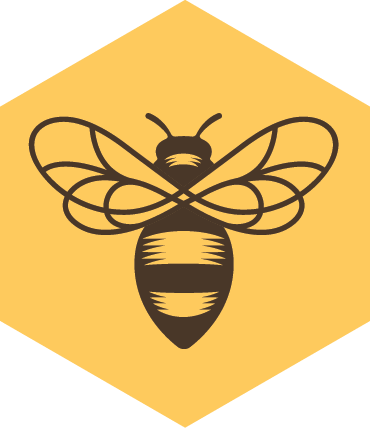Burt's Bees Creates Wild For Bees
A collaboration between art and science in service to the bees
Published 06-18-12
Submitted by Burt's Bees
It turns out Bees do more than most people realize--for such small, short-lived creatures, they do a lot of heavy lifting to keep life on Earth in balance. In fact, one third of the most delicious and nutritious foods on Earth simply wouldn’t exist without bees. Because they are instrumental to biodiversity, they are what scientists call indicator species, so they function as a buzzing alarm system for the health of our planet’s ecosystem.
And the alarm is sounding. Since 2006, colonies of honey bees have seen population declines at around 30% each year. Some of the declines are attributed to a mysterious evacuation of the hive by its workers, which soon spells collapse for the hive, hence the name Colony Collapse Disorder or CCD. Researchers around the world have been focused on trying to solve the mystery, but most agree there is no singular threat. Rather, bees and honey bees in particular are facing a number of challenges—pollution, exposure to chemicals, disease, parasites, poor nutrition, even changes in climate.

As P2’s Executive Director, Laurie Davies Adams, explains, “Each of us lives in a habitat, and we have the opportunity, in fact, the responsibility, to nurture and promote healthy habitat. By sharing a bit of lawn, a school yard, a farm border, an office landscape or a roadside with blooming pollinator-friendly plants, we create a connection that supports healthy ecosystems and a sustainable future. All of our actions join to build something invaluable to the very plants and pollinators that feed us.”
Burt Shavitz, co-founder of Burt’s Bees was a beekeeper. His bees made the wax in their first Beeswax Lip Balm, so bees aren’t just in the name. That’s why Burt’s Bees is collaborating with bee experts at the Pollinator Partnership and artists to get people to care about bees.
This June for National Pollinator Week, Burt’s Bees will premiere BURT TALKS TO THE BEES, a wonderfully fantastical and wildly educational series of three short films created by Isabella Rossellini, actor, director and uncanny Burt impersonator. You will meet the bees--the queen, the workers and the drones—so we can all become familiar and sympathetic to their plight. Rossellini’s uncanny ability to combine scientific accuracy with storytelling creates a zany, lighthearted approach to environmentalism that piques viewers’ curiosity just enough to care about a disappearing bug.
 “At Burt’s Bees, we’ve always taken Colony Collapse Disorder and the health of the honeybees very seriously,” says Burt’s Bees Vice President of Customer Strategy and Marketing, Jim Geikie, “The opportunity to work with Isabella on this film project has given us the chance to shed light on this important issue in an incredibly artful and theatrical new way that I think viewers will really enjoy.”
“At Burt’s Bees, we’ve always taken Colony Collapse Disorder and the health of the honeybees very seriously,” says Burt’s Bees Vice President of Customer Strategy and Marketing, Jim Geikie, “The opportunity to work with Isabella on this film project has given us the chance to shed light on this important issue in an incredibly artful and theatrical new way that I think viewers will really enjoy.”
Coinciding with the launch of the films, Burt’s Bees will launch a website providing all the information and tools people need to do their part for the bees—everything from guerilla gardening to tips on hanging out with bees fearlessly. If each one of us invites bees into our space by planting even a patch of bee food, together we can create a veritable bee sanctuary--and a more sustainable future for all.
To view the film series and create wild for bees, visit http://www.burtsbees.com/wildforbees.
BURT’S BEES
Burt’s Bees has been offering distinctive earth-friendly, natural health and beauty care products for 25 years. From a beekeeper’s backyard in Maine to the leading edge of natural, Burt’s Bees knows natural health and beauty care solutions from head-to-toe. The brand creates products for total skin health that keep The Greater Good™ top of mind. Burt’s Bees has approximately 400 employees with products available in the United States and over 35 countries worldwide as well as on its website http://www.burtsbees.com. No petrochemicals, no phthalates, no parabens and no sodium lauryl sulfate. Not tested on animals.
POLLINATOR PARTNERSHIP
Established in 1997, Pollinator Partnership is the largest 501(c)3 non-profit organization dedicated solely to the health, protection, and conservation of pollinating animals. The Pollinator Partnership’s mission is to promote the health of pollinators, critical to food and ecosystems, through conservation, education, and research. Visit www.pollinator.org for more information and to download a free pollinator friendly planting guide for your ecoregion.

Burt's Bees
Burt's Bees
Burt’s Bees® has been offering distinctive earth-friendly, natural health and beauty care products for 30 years. From a beekeeper’s backyard in Maine to the leading edge of natural, Burt’s Bees knows natural body care solutions from head-to-toe and operates with The Greater Good™ top of mind. Formulated without parabens, phthalates, petrolatum or SLS and no animal testing. To find out more, please visit www.burtsbees.com.
More from Burt's Bees

